|
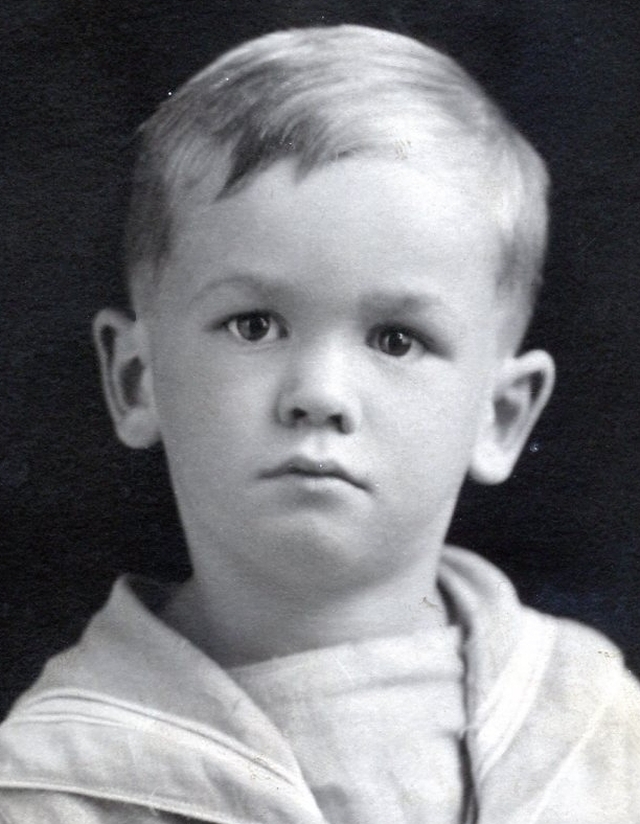 Corey Leroy "Roy" Sanders was born
in Hillier Ontario and, as a toddler, moved to another small farm in Prince
Edward County, just outside Bloomfield, where they sold their vegetables.
Growing up in this small, tight-knit community in The County, Roy acquired a
wide
array of practical skills which he
applied throughout his long and eventful life. Tragedy struck Roy's already poor
farming family when his young father died of Parkinson's disease in 1939. This event,
just a few days after Roy's 15th birthday, intensified his family's hardships
during the Great Depression. (Read Roy's powerful and shocking memories of this
period in his life: "Feelings
on Growing up in the Thirties.") Corey Leroy "Roy" Sanders was born
in Hillier Ontario and, as a toddler, moved to another small farm in Prince
Edward County, just outside Bloomfield, where they sold their vegetables.
Growing up in this small, tight-knit community in The County, Roy acquired a
wide
array of practical skills which he
applied throughout his long and eventful life. Tragedy struck Roy's already poor
farming family when his young father died of Parkinson's disease in 1939. This event,
just a few days after Roy's 15th birthday, intensified his family's hardships
during the Great Depression. (Read Roy's powerful and shocking memories of this
period in his life: "Feelings
on Growing up in the Thirties.")
The profound childhood experiences
described by Roy in these powerful memories deeply affected him throughout his life.
Roy always worked
very hard, he was frugal, prudent and practical, and he showed great talent for creative ingenuity and
pragmatic inventiveness. He also had great empathy for others, especially those less
fortunate than himself, and he passionately believed in the need for people to
work together, to cooperate and to share their common resources for the betterment of
all.
 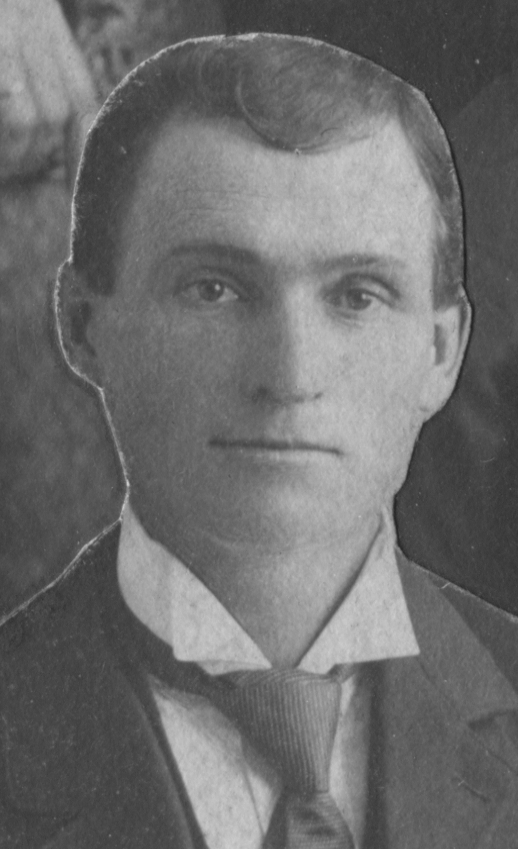 The
War Years The
War Years
In 1942, at the age 18, Roy was moved to sign up for military service. His
paternal grandfather, Albert Franklin Sanders (see right), told Roy that he would be the first in his family
line to join any armed force. However, Grandpa Sanders understood Roy's desire to contribute to the
fight against Nazism and fascism. Decades earlier, Roy's grandfather had built several
houses, and then sold them to buy farms in Hillier for Roy's Dad, Arthur, and his
brother Warden. Albert made this sacrifice so that his sons would not be conscripted
in WWI. (Besides being a carpenter, Albert was a great fiddler who led his
children in a successful band called the "Smokeville Five" which played at barn
dances throughout The County.)
Because
Roy had excelled in school and had an aptitude for math and science, he was
channelled into the then just-emerging, top-secret field of RADAR. In
1943, after training as an Air Force RADAR technician, Roy and a small team were
sent to western India where they
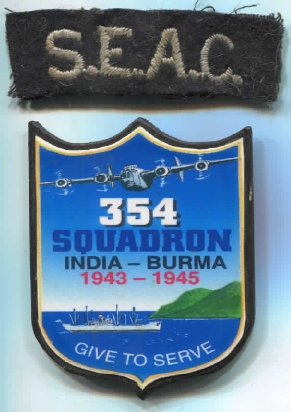 spent two years maintaining RADAR equipment aboard Liberator
bomber aircraft. These aircraft, with 354 Squadron of South East
Asia Command (SEAC), did reconnaissance patrols over the Bay of Bengal watching
for Japanese ships and submarines going to and from occupied Burma. Roy was initially posted to Cuttack, in Orissa,
where he was known as "Sandy." In
late 1944 and early 1945, he and fellow
ground crew technicians were deployed to
Minneriya in Ceylon. One of his stories
from India was that he built a radio which he and the crew used to listen to an
announcement that the US had exploded an atomic bomb on Japan.
Read much more here about Roy's
two years with the 354th Squadron in India. spent two years maintaining RADAR equipment aboard Liberator
bomber aircraft. These aircraft, with 354 Squadron of South East
Asia Command (SEAC), did reconnaissance patrols over the Bay of Bengal watching
for Japanese ships and submarines going to and from occupied Burma. Roy was initially posted to Cuttack, in Orissa,
where he was known as "Sandy." In
late 1944 and early 1945, he and fellow
ground crew technicians were deployed to
Minneriya in Ceylon. One of his stories
from India was that he built a radio which he and the crew used to listen to an
announcement that the US had exploded an atomic bomb on Japan.
Read much more here about Roy's
two years with the 354th Squadron in India.
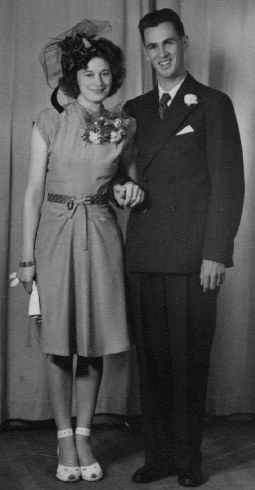 On his way home to Canada after the war, Roy stopped
in Britain where he met his warbride-to-be,
Sylvia Whittlesey, of
Birmingham. They met at a "tea dance" in Bournemouth in November 1945.
After dating five times, Roy return to Canada aboard a troopship the following
month. After exchanged letters for a few months Roy mailed Sylvia a ring
in the spring of 1946. Unless she accepted it as an engagement
ring, she would have to pay customs! Sylvia decided to give Roy a chance
and made plans for a six-month trial visit to Canada. She arrived on July
18th in a converted, 18-passenger Lancaster bomber. On his way home to Canada after the war, Roy stopped
in Britain where he met his warbride-to-be,
Sylvia Whittlesey, of
Birmingham. They met at a "tea dance" in Bournemouth in November 1945.
After dating five times, Roy return to Canada aboard a troopship the following
month. After exchanged letters for a few months Roy mailed Sylvia a ring
in the spring of 1946. Unless she accepted it as an engagement
ring, she would have to pay customs! Sylvia decided to give Roy a chance
and made plans for a six-month trial visit to Canada. She arrived on July
18th in a converted, 18-passenger Lancaster bomber.
Soon after her arrival, they decided to speed up
their plans and were married on July 27, 1946. When it came to the part of the
wedding ceremony when the United Church Minister asked Sylvia
to vow that she would always "honour and obey" Roy, she said yes she would
honour him, but no, she would not "obey" him. The proceedings
stopped while they discussed this unusual situation (brought on by a
woman named for suffragette
Sylvia Pankhurst).
Because Roy was happy to go along with Sylvia's feminism, the wedding proceeded. This
was an auspicious beginning to a long and eventful partnership
which lasted until Sylvia's death 61 years later.
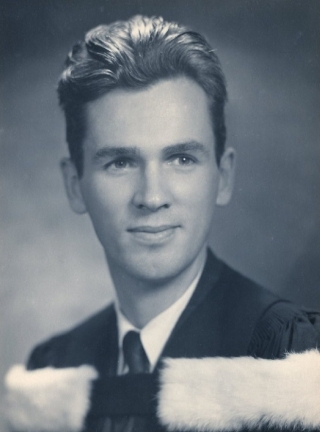 (Read
the letter of invitation to
their 50th wedding anniversary in 1996, which summarising some highlights of
their life together.) (Read
the letter of invitation to
their 50th wedding anniversary in 1996, which summarising some highlights of
their life together.)
The World of
Physics
After taking advantage of a government program for returning veterans, Roy
finished two years of high school in six months. This was necessary so that he
could start studying math and
physics at the University of Toronto in September. After receiving his BA in 1950
(see graduation photo, right), Roy was
thinking he'd get a job in astrophysics at an observatory. However, this
plan was set aside when he landed a job as a "Junior Research
Officer I" with the
Canadian government's National Research Council (NRC) in Ottawa. This
was the beginning of his career in applied physics (optics) which ended with his
retirement in 1979 when he was Senior Research Officer.
In early 1953, Roy, Sylvia and their first
daughter, Heather, moved to Britain where he began studies at the University of
London's Imperial College of Science. (Read
Heather's personal description of those years.) While maintaining his work position
at NRC, Roy completed his Ph.D.
in the university's Department of Technical Optics (Colour). After
receiving his doctorate in late 1955, Roy returned to work at NRC
and remained there until his retirement in 1979.
 Roy's
career in NRC's Applied Physics division involved
understanding many
technical aspects of optics, from photometry,
color rendering,
the Primary Standard of Light and
the relationship between lightness and luminance.
His work there also meant mastering the use of complex instruments, like lasers
and spectroradiometers. He even designed and built spectroradiometers for
NRC's use. These devices were used in Roy's labs to
measure the spectral power
distribution of light sources.
While to the layperson this may all sound rather abstract and theoretical, his NRC
career was actually focused on the practical application of optical physics to
solve very down-to-earth problems. For example, his work involved such matters
as determining the best colour to be used for turning signals used by cars
around the world, photometric and colorimetric measurements to improve flashing
lights on emergency vehicles, the refininement of fluorescent lamps, calibrating
and standardising the colour
used by TV-studio monitors, and establishing the exact shade of red for use in
Canada's maple-leaf flag. Read more about
Roy's work
as a physicist and see a list of papers that he wrote for
international scientific journals. Learn more about his work life from
the memories of fellow NRC employees:
Alan Robertson,
Clarence Dodd, Graham Fielder
and
Gary Schofield. Roy's
career in NRC's Applied Physics division involved
understanding many
technical aspects of optics, from photometry,
color rendering,
the Primary Standard of Light and
the relationship between lightness and luminance.
His work there also meant mastering the use of complex instruments, like lasers
and spectroradiometers. He even designed and built spectroradiometers for
NRC's use. These devices were used in Roy's labs to
measure the spectral power
distribution of light sources.
While to the layperson this may all sound rather abstract and theoretical, his NRC
career was actually focused on the practical application of optical physics to
solve very down-to-earth problems. For example, his work involved such matters
as determining the best colour to be used for turning signals used by cars
around the world, photometric and colorimetric measurements to improve flashing
lights on emergency vehicles, the refininement of fluorescent lamps, calibrating
and standardising the colour
used by TV-studio monitors, and establishing the exact shade of red for use in
Canada's maple-leaf flag. Read more about
Roy's work
as a physicist and see a list of papers that he wrote for
international scientific journals. Learn more about his work life from
the memories of fellow NRC employees:
Alan Robertson,
Clarence Dodd, Graham Fielder
and
Gary Schofield.
 Roy represented Canada
within scientific organisations
such as
the International Bureau of Weights and Measures (BIPM) and
the
International Commission on Illumination (CIE).
Throughout the 1960s
and 1970s he
served in various leadership positions on working groups, technical
committees and
subcommittees of these organisations. Perhaps most notably, his
responsibilities included chairing the BIPM's Working Group on the Primary
Standard of Light (1962-1971) and chairing the CIE's Photometry and Radiometry
Committee (1971-1979). He was also active within the Canadian National
Committee of the CIE from 1961 to 1979, serving as its secretary (1961-1963),
its president (1963-1967) and its vice president (1972-1975). See
a more complete list of the positions Roy held at NRC and within these international
organisations. Roy represented Canada
within scientific organisations
such as
the International Bureau of Weights and Measures (BIPM) and
the
International Commission on Illumination (CIE).
Throughout the 1960s
and 1970s he
served in various leadership positions on working groups, technical
committees and
subcommittees of these organisations. Perhaps most notably, his
responsibilities included chairing the BIPM's Working Group on the Primary
Standard of Light (1962-1971) and chairing the CIE's Photometry and Radiometry
Committee (1971-1979). He was also active within the Canadian National
Committee of the CIE from 1961 to 1979, serving as its secretary (1961-1963),
its president (1963-1967) and its vice president (1972-1975). See
a more complete list of the positions Roy held at NRC and within these international
organisations.
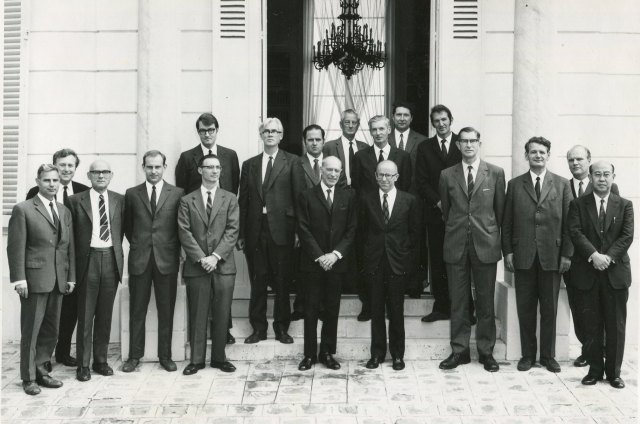 Travel:
For Work and Pleasure Travel:
For Work and Pleasure
Because of his work, Roy traveled to conferences in Canada, the US and Europe. Through these meetings with fellow
scientists, he made lasting connections and friendships. (In this photo of
the BIPM's Photometry Committee in Paris, 1971, Roy is 7th from the left.)
During Roy's travel to work conferences, he was
sometimes able to combine work with pleasure. For instance, whenever Sylvia
accompanied him on these trips, they made sure to include not only the usual
sightseeing tours, but more extended and unusual holiday travels as well. Roy and Sylvia's curiosity about other cultures, history, nature and genealogy, and
their desire
to promote peace and understanding between East and West, North and South, fed their
life-long enthusiasm for exploring the
world.
Roy and Sylvia passed on this "travel bug" to their
children. Besides car-camping trips across Canada (one to BC
and another to Nova Scotia), there were other family trips to explore the
eastern US. In the 1970s, Wendy travelled with them to
BC and Florida, while Richard joined them on a journey through Guatemala and
into Honduras. That trip involved Roy driving a jeep 1500 kms through jungles and mountains to
see the ruins of ancient Mayan cities.
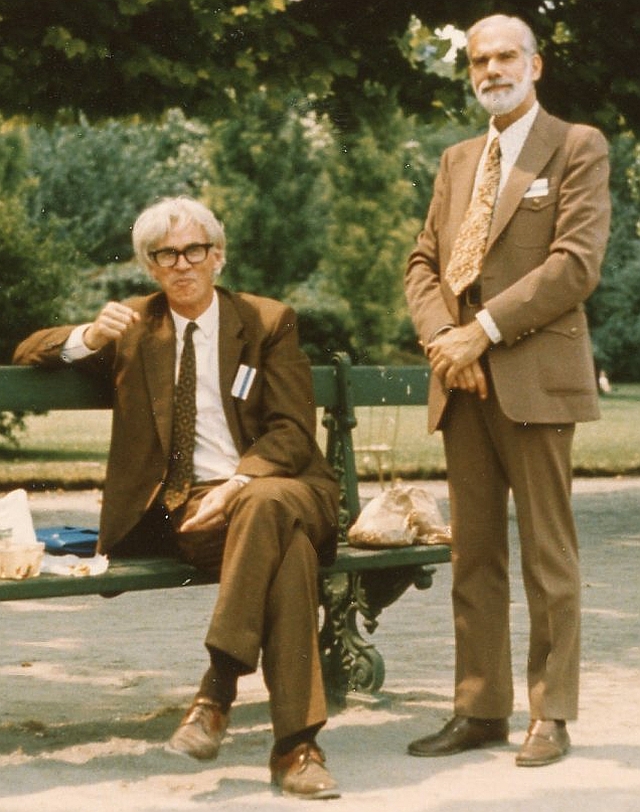 Thanks
to his career in physics, Roy and Sylvia had the opportunity to glimpse into the
lives and cultures of people in both western and eastern Europe. Their
journeys to the east included visits to Czechoslovakia, Hungary and the USSR in
the 1960s and 1970s. During one such work-related trip, in 1971, Roy was
accompanied by Sylvia and their younger children, Wendy and Richard, to
Budapest. Then, while Roy went off to work meetings in France, they flew
to Dubrovnik in Yugoslavia and traveled overland to meet up with him in
Barcelona. Learn more
about these and many other journeys and adventures with Roy and Sylvia. Thanks
to his career in physics, Roy and Sylvia had the opportunity to glimpse into the
lives and cultures of people in both western and eastern Europe. Their
journeys to the east included visits to Czechoslovakia, Hungary and the USSR in
the 1960s and 1970s. During one such work-related trip, in 1971, Roy was
accompanied by Sylvia and their younger children, Wendy and Richard, to
Budapest. Then, while Roy went off to work meetings in France, they flew
to Dubrovnik in Yugoslavia and traveled overland to meet up with him in
Barcelona. Learn more
about these and many other journeys and adventures with Roy and Sylvia.
Despite the extreme, political and military paranoia
that characterised the Cold War, Roy was open to mixing business and pleasure
with scientists on both sides of the "Iron Curtain." The warmth of these
friendships, east and west, can be seen in letters he received from colleagues
in the US and the USSR. These work friends included Luke Thorington and Dr. Vera
Kartachevskaia.
 Luke,
who was the leading engineer at Duro-Test Corp. (America's largest light
manufacturer), brought his son John to the Sanders' cottage in the early
1970s. (See photo of Roy and Luke, at break during a European conference,
above left.) Mme. V.E. Kartachevskaia was a leading Soviet physicist who, for
decades, headed the Photometry Lab at the Mendeleev Institute of Métrology.
When Roy and Sylvia visited Leningrad in the 1960s for a physics conference,
Mme. V.E. Kartachevskaia took them around to see many sites in her city and they
kept in touch for decades. In 1985, when Roy, Sylvia and Richard went on
an "Adventure Peace Tour to the
USSR," they visited her in Leningrad. (See image, right.)
Click here to
read some of their letters to Roy, which mixed business with pleasure. Luke,
who was the leading engineer at Duro-Test Corp. (America's largest light
manufacturer), brought his son John to the Sanders' cottage in the early
1970s. (See photo of Roy and Luke, at break during a European conference,
above left.) Mme. V.E. Kartachevskaia was a leading Soviet physicist who, for
decades, headed the Photometry Lab at the Mendeleev Institute of Métrology.
When Roy and Sylvia visited Leningrad in the 1960s for a physics conference,
Mme. V.E. Kartachevskaia took them around to see many sites in her city and they
kept in touch for decades. In 1985, when Roy, Sylvia and Richard went on
an "Adventure Peace Tour to the
USSR," they visited her in Leningrad. (See image, right.)
Click here to
read some of their letters to Roy, which mixed business with pleasure.
Struggles
for Peace
Starting in the late 1950s, Roy and Sylvia worked together on peace, justice and
human rights campaigns through a variety of progressive non-governmental organisations.
While during the decades of his NRC career, Sylvia often took the lead on
these initiatives, Roy was always supportive and involved. Their early
participation in peace and social
justice efforts coincided with their involvement in Ottawa's First Unitarian Congregation in 1953. Friendships with Unitarian activists remained an important part of their
lives for many decades
and, in the 1990s, they were involved in forming the Unitarian Universalist Fellowship
of Ottawa. Throughout the 1960s and 1970s, they were engaged in a wide
range of peace and human rights issues. For example they helped organise Ottawa
solidarity events for the US civil rights movement and brought American
activists to speak in Ottawa. They also supported the anti-apartheid movement
that opposed the systemic racism and state violence in South Africa. During the Cold War,
they raised public awareness about the atmospheric
testing of nuclear bombs and the health and environmental effects of radioactive
fallout that was drifting across North America from the hundreds of explosions
that the US had set
off in Nevada. They also protested
the US war in southeast Asia, and highlighted the complicity of the Canadian
government and corporations in the Vietnam War. They opposed Nobel-Peace
Laureate Prime Minister Pearson's Liberal government when it
allowed Bomarc missiles, armed with US nuclear warheads, to be based in Quebec and BC.
For decades, they were active in the NDP, although
this often meant trying to move the party to the left and to embrace stronger
ant-war policies. Through the Waffle movement in the early 1970s, Sylvia
especially tried to move the party
towards socialist perspectives, and Roy was on board. As part of his involvement in
these struggles, Roy used a wide variety of tools, and was not afraid to get his
hands dirty! He operated Gestetners to run off copies and silk-screen
contraptions to produce coloured signs. Being a relentless letter writer
he quickly adapted from old typewriters to newfangled DOS home computers in
the very early 1980s.
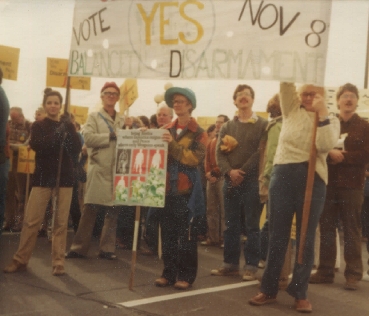 After
his retirement, Roy was able to focus more attention on peace and
disarmament issues and fully joined Sylvia in her tireless efforts. In the late 1970s
and early 1980s, the couple were central to many peace movement activities in
Ottawa. This included working through the National Capital branch of Operation
Dismantle and helping to create and sustain the Gloucester Peace Group. (See Roy
and Sylvia in image at left.) After
his retirement, Roy was able to focus more attention on peace and
disarmament issues and fully joined Sylvia in her tireless efforts. In the late 1970s
and early 1980s, the couple were central to many peace movement activities in
Ottawa. This included working through the National Capital branch of Operation
Dismantle and helping to create and sustain the Gloucester Peace Group. (See Roy
and Sylvia in image at left.)
During the 1980s, Roy was also involved in
supporting several other peace groups, including the Ottawa chapter of Veterans
Against Nuclear War, and national organisation based in Toronto called Science
for Peace. Along with other friends and activists in Ottawa's peace
community whom he had known for decades be was involved in starting a group
called Educating for Peace and he worked on various projects and activities with
the city's Peace Resource Centre.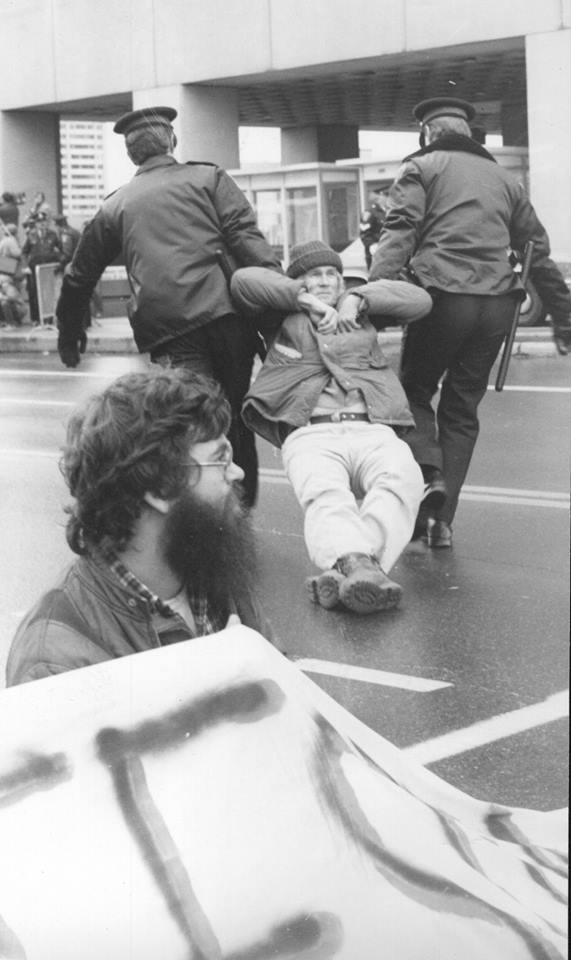
When their son Richard, who shared their deep
commitment to the peace movement, took up this struggle fulltime in 1984, they
supported his efforts and, throughout the late 1980s, joined him in organising civil
disobedience campaigns for the Alliance for Nonviolent Action (ANVA). They were
all arrested at a few ANVA actions opposing Canadian complicity in NATO's
low-level test flights, the Star-Wars weapons program, and the international
arms trade. On one occasion, all three were arrested together when joining 50
others from across Ontario and Quebec for a "sit in" in front of Canada's War
Department in downtown Ottawa. (See image at right, and read a funny story about
it on the "Peace" page.)
 When
Richard started the
Coalition to Oppose the Arms Trade (COAT) in late
1988, Roy and Sylvia were very much involved. For the next 15 years, until
Sylvia's stroke, they were both key COAT supporters, organisers and volunteers.
As part of COAT's steering committee, they helped
to plan and carry out numerous large events in Ottawa, from protests against
various wars, to candlelight vigils outside weapons events and information
tables at Ottawa's militarised air shows, to promoting our peace and conversion
conferences, war-toy recycling depots, and social events to build Ottawa's
activist community. They were also involved in helping COAT's
national campaigns and its publication, Press for Conversion! In
1996, to honour their special role in the organisation, and to commemorate their
many decades of work in the peace movement in general, COAT organising a large
"Potluck Dinner Party" to celebrate
their 50th wedding anniversary. When
Richard started the
Coalition to Oppose the Arms Trade (COAT) in late
1988, Roy and Sylvia were very much involved. For the next 15 years, until
Sylvia's stroke, they were both key COAT supporters, organisers and volunteers.
As part of COAT's steering committee, they helped
to plan and carry out numerous large events in Ottawa, from protests against
various wars, to candlelight vigils outside weapons events and information
tables at Ottawa's militarised air shows, to promoting our peace and conversion
conferences, war-toy recycling depots, and social events to build Ottawa's
activist community. They were also involved in helping COAT's
national campaigns and its publication, Press for Conversion! In
1996, to honour their special role in the organisation, and to commemorate their
many decades of work in the peace movement in general, COAT organising a large
"Potluck Dinner Party" to celebrate
their 50th wedding anniversary.
Click here to learn more about Roy's
six decades of peace activism here.
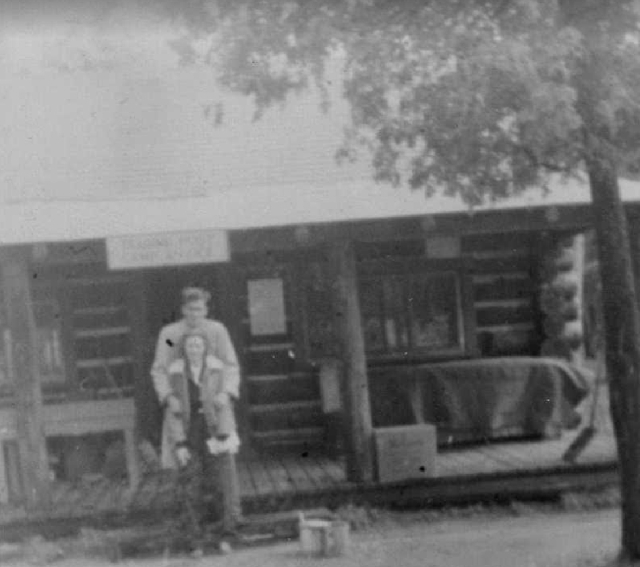
Cottage Life
But Roy and Sylvia's lives were not consumed by the peace movement, or by other
urban work endeavours. They showed a keen interest in experiencing the
wilderness, during camping trips, and time in forest cabins near lakes.
The first known example of "cottage life" was in 1947 when they visited Roy's
war buddy, Omer Stringer, at his camp (Tamakwa) in Algonquin Park. It was Roy and Sylvia's
honeymoon! (See photo, right.)
As life-long do-it-yourselfers, Roy
and Sylvia worked as a design-build team on three major projects. Besides
designing and helping build their passive solar home in 1960, they also
planned and constructed two cottages. For more than 50 years they found great respite
 on Lac Pemichangan north of Ottawa and spent decades working to
improve their piece of off-the-grid paradise. The adventure began with
the building of a log cottage on Shouldice Bay in 1957. (See photo, left.) on Lac Pemichangan north of Ottawa and spent decades working to
improve their piece of off-the-grid paradise. The adventure began with
the building of a log cottage on Shouldice Bay in 1957. (See photo, left.)
Another project
began in 1971 when they saved a 150-year old farm house that was doomed to
be turned into docks. They had the building disassembled, log by log, and
then moved by
horse and sleigh three kilometres across Pemichangan's winter ice to a new home
on Baie Noire. It was reassembled there in the spring. (See image below.) Learn
more about this second cottage from the memories of
John Hefler,
Kay Hefler,
Hilary Horan and Barbara
Lunney.
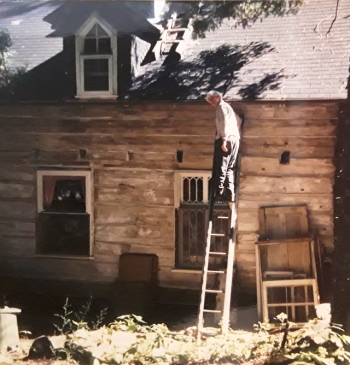 Besides providing a respite from the city, and the stresses of work there --
both in the field of physics and peace activism -- cottage life also allowed them
opportunities to enjoy sharing time with family and friends. For Roy it
was also an opportunity to return to his country roots and to express his
pioneer creativity. Cottage life was a time when he could use all manner
of tools from antique wooden planes, pulleys, hand augers, axes and adzes to
modern gadgets like chain saws and solar panels. (Read Richard's "The
Tools my Dad used.") Besides providing a respite from the city, and the stresses of work there --
both in the field of physics and peace activism -- cottage life also allowed them
opportunities to enjoy sharing time with family and friends. For Roy it
was also an opportunity to return to his country roots and to express his
pioneer creativity. Cottage life was a time when he could use all manner
of tools from antique wooden planes, pulleys, hand augers, axes and adzes to
modern gadgets like chain saws and solar panels. (Read Richard's "The
Tools my Dad used.")
Roy and Sylvia loved swimming, sailing,
fishing, climbing the hills around the lake, exploring its many hidden bays by
boat,
hearing the loons, viewing and experiencing wildlife closeup, and retelling true
stories like the time a big black bear knocked open their door and invited
itself in for a taste of Sylvia's tasty stew. Sylvia and Roy, alone at
their cottage home, were enjoying a pleasant afternoon nap when the bear
arrived for a late lunch. Hearing the crashing of their door being knocked open
and the pressure cooker hitting the floor, Sylvia went into the kitchen and was
surprised to find a bear. The bear, surprised to hear Sylvia making her
own loud noises, finally turned and lumbered off outside. Roy then came
lumbering in to say: "What's all the commotion about?"
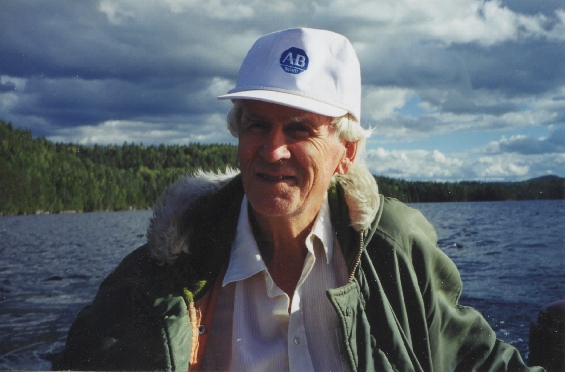 The
glory days of their cottage life came to an abrupt end years later when Sylvia,
following a hip replacement in 2002, suffered a heart attack and stroke.
Although she never lost her great humour, wit and caring personality, Sylvia was
paralysed on one side and bedridden. For the next five years, Roy was her
primary care giver, helping see to her daily needs at their cottage-like home.
Throughout those very trying and difficult years, friends and family rallied
round, and Roy and Sylvia endured. They even continued to host some lively
musical parties. When Sylvia died in 2007 it was the end of an era,
especially for Roy. Coping alone at home eventually became too much and he
moved into a City of Ottawa seniors residence. The
glory days of their cottage life came to an abrupt end years later when Sylvia,
following a hip replacement in 2002, suffered a heart attack and stroke.
Although she never lost her great humour, wit and caring personality, Sylvia was
paralysed on one side and bedridden. For the next five years, Roy was her
primary care giver, helping see to her daily needs at their cottage-like home.
Throughout those very trying and difficult years, friends and family rallied
round, and Roy and Sylvia endured. They even continued to host some lively
musical parties. When Sylvia died in 2007 it was the end of an era,
especially for Roy. Coping alone at home eventually became too much and he
moved into a City of Ottawa seniors residence.
 Even
Later in Life: Still Growing and
Playing Even
Later in Life: Still Growing and
Playing
Throughout his long life, Roy's personality was
typified by an extremely calm, quiet and gentle manner. He had a soft spoken,
gentle, slow and highly-reasoned approach to the world. This trait served
him very well in many problem solving endeavours, from his work in physics and
the peace movement, building and fixing things at home and the cottage, and
caring for Sylvia during her last years.
It was also a useful strategy in many games and
sports. Roy also had a
highly-competitive streak and struggled to win at whatever games he played. This
was well known to everyone with whom he played chess, cribbage, rummy and
bridge, the latter of which he played into his 80s. But it was certain physical
sports which he loved the most.
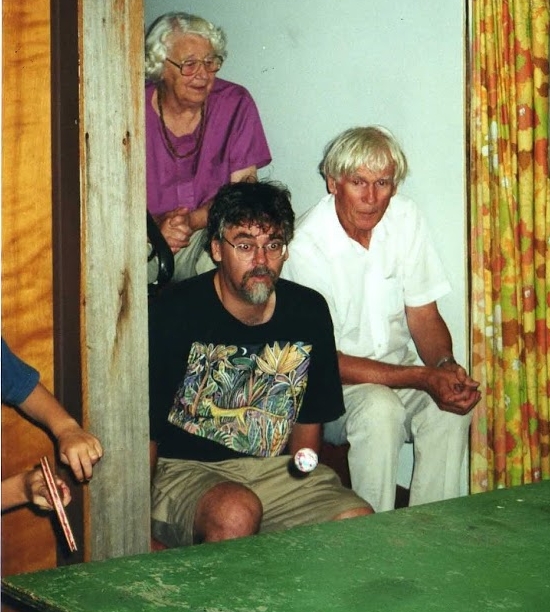 These
involved using rackets to hit small spherical objects over nets. His
strategy in these games involved movements that were at times slow and highly
calculated, to strikes of lightning speed that could surprise and hopefully
intimidate his fiercest opponents. These
involved using rackets to hit small spherical objects over nets. His
strategy in these games involved movements that were at times slow and highly
calculated, to strikes of lightning speed that could surprise and hopefully
intimidate his fiercest opponents.
Over many decades, table tennis was the game he
played with the greatest skill, vigour and speed. Having learned it as a youth in
The County, he later brought the game to work where he played regularly at lunch
with NRC colleagues. Besides playing in Ottawa tournaments, where he won 2nd
prize in 1973, Roy enjoyed the sport regularly at home. (See Sylvia, Roy and
Richard watching a game in the basement.) Later in life, he took up tennis and
had great fun playing the sport with friends and family, into his late 70s.
During his 90s, some of his most enjoyable moments at the Garry Armstrong care
facility, came when batting a beach ball back and forth with Heather, Wendy,
Richard, his wife Susan and Roy's grandchildren Arthur and Erica.
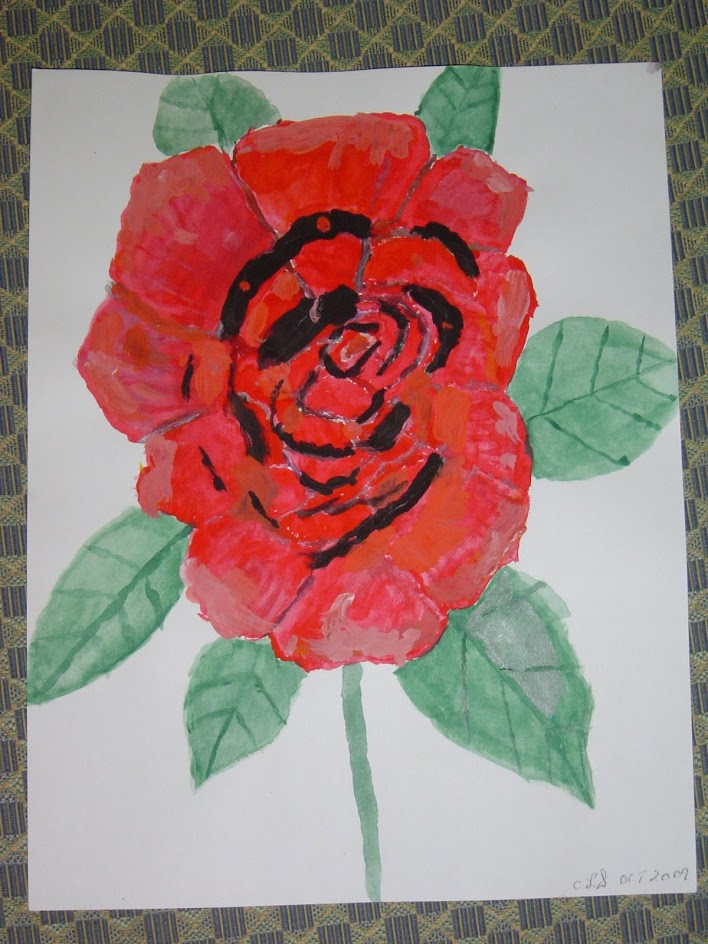  Another
late-life passtime, at the Garry Armstrong care facility, was to begin
painting in his late 80s. In this endeavour, he focused his eye on
rendering colourful images of flowers. (See left.) This reflected one of Roy's
great, life-long passions which had begun during his childhood in The County.
Roy never lost touch with his farming origins.
He always enjoyed growing and then harvesting the products of his labour.
He even tried his hand at cottage gardening but the thick forest cover proved an
unbeatable adversary, except for the shore-side blackcurrants. At his suburban
home, lawn-fixated neighbours were chagrined by the Sanders' front yard which was
overgrown with a thrivingly productive jungle of raspberries and other edibles.
In his late 80s, Roy devoted much time to nurturing indoor flowers. Roy
also used some of his time to complete complex jigsaw puzzles. (See image at
right. Note his window garden in the background.) Another
late-life passtime, at the Garry Armstrong care facility, was to begin
painting in his late 80s. In this endeavour, he focused his eye on
rendering colourful images of flowers. (See left.) This reflected one of Roy's
great, life-long passions which had begun during his childhood in The County.
Roy never lost touch with his farming origins.
He always enjoyed growing and then harvesting the products of his labour.
He even tried his hand at cottage gardening but the thick forest cover proved an
unbeatable adversary, except for the shore-side blackcurrants. At his suburban
home, lawn-fixated neighbours were chagrined by the Sanders' front yard which was
overgrown with a thrivingly productive jungle of raspberries and other edibles.
In his late 80s, Roy devoted much time to nurturing indoor flowers. Roy
also used some of his time to complete complex jigsaw puzzles. (See image at
right. Note his window garden in the background.)
At the age of 89, Roy put his mind to trying to solve
one of the greatest puzzles in the universe! This was a grand enigma which had
long intrigued him: the origins of the cosmos! Using his mastery of
theories that explain optics, stellar
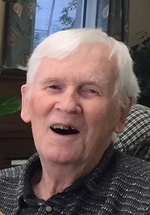 physics, solar radiation and the movement of light through
infinite space, he came up with a hypothesis that he was confident could debunk the prevailing cosmological model known as the "Big Bang." Roy's
controversial astrophysical idea challenging this official scientific narrative
coincided with his longstanding opposition to creationism, and his strong
commitment to atheism. Seeing the universe as infinite in both space and
time, he argued that the idea of a supposed "Big Bang" is a chimera caused by
false scientific assumptions based on an optical illusion. This
Doppler-like illusion, he argued, was caused by the journey of light through
dark matter and dark energy.
Read about his antiBig-Bang ideas
here. physics, solar radiation and the movement of light through
infinite space, he came up with a hypothesis that he was confident could debunk the prevailing cosmological model known as the "Big Bang." Roy's
controversial astrophysical idea challenging this official scientific narrative
coincided with his longstanding opposition to creationism, and his strong
commitment to atheism. Seeing the universe as infinite in both space and
time, he argued that the idea of a supposed "Big Bang" is a chimera caused by
false scientific assumptions based on an optical illusion. This
Doppler-like illusion, he argued, was caused by the journey of light through
dark matter and dark energy.
Read about his antiBig-Bang ideas
here.
Throughout his own bright journey through life, Roy
always thrived on learning. While always trying to expand his knowledge
and understanding of how the physical universe works, he also enjoyed exploring
the natural world and finding his unique place within it. He strove to
apply his thorough grasp of the theories of physics to master many practical
techniques, technologies and tools which he used in his daily life, both at work
and at play. His tool kit was huge and he made his mark on the world using
everything from household hammers to spectroradiometers, and from tennis
racquets to protest signs. Roy and Sylvia were both generous with their
knowledge and skills. They taught us much about many things and they will
continue to do so.
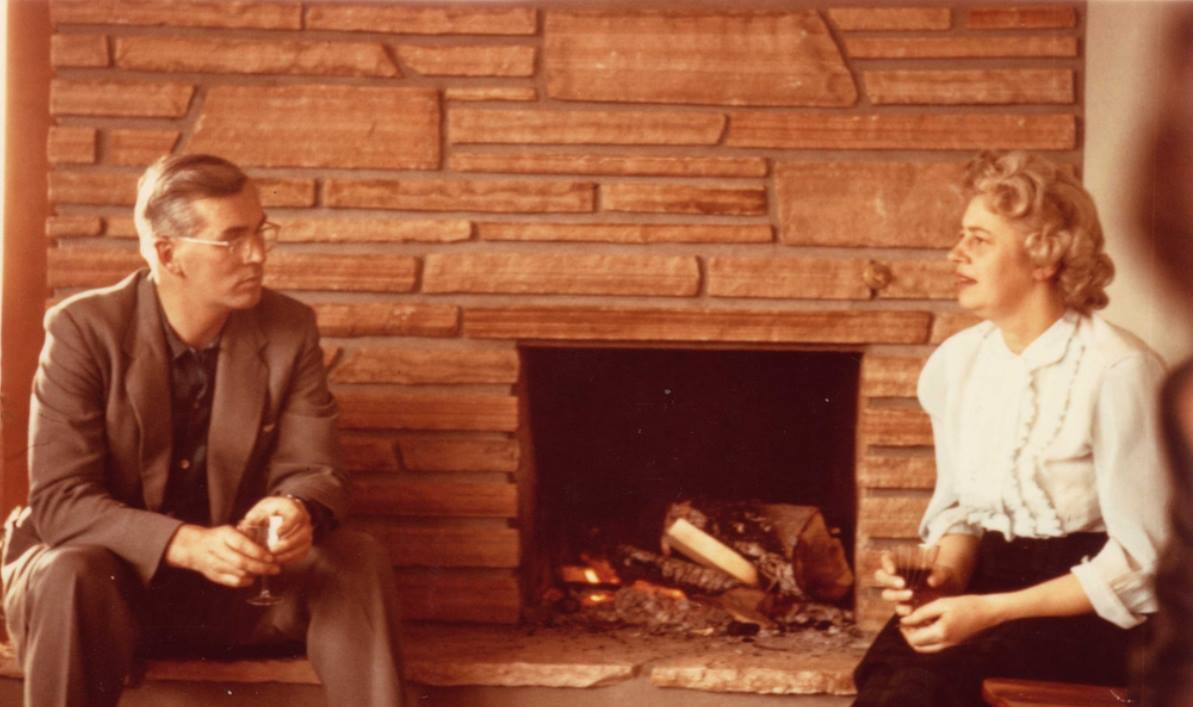
Roy and Sylvia Sanders were
married for 61 years. They are seen here, in about 1960,
in their new, passive solar home
in Ottawa,
which they designed and helped build together.
While Roy was an ever practical scientist, Sylvia was an artist and had an eye
for the aesthetic.
Together they made an amazing team and they will never be forgotten.
Have something to add?
If you have any further information or
photos that you could share for this page of the Roy Sanders memorial website, please let me know.
Many thanks!
Richard Sanders <overcoat@rogers.com> |







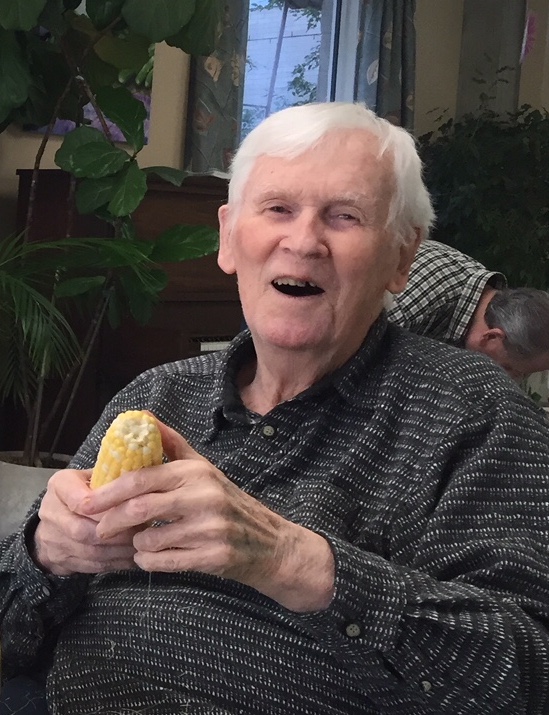
 Corey Leroy "Roy" Sanders was born
in Hillier Ontario and, as a toddler, moved to another small farm in Prince
Edward County, just outside Bloomfield, where they sold their vegetables.
Growing up in this small, tight-knit community in The County, Roy acquired a
wide
array of practical skills which he
applied throughout his long and eventful life. Tragedy struck Roy's already poor
farming family when his young father died of Parkinson's disease in 1939. This event,
just a few days after Roy's 15th birthday, intensified his family's hardships
during the Great Depression. (Read Roy's powerful and shocking memories of this
period in his life: "
Corey Leroy "Roy" Sanders was born
in Hillier Ontario and, as a toddler, moved to another small farm in Prince
Edward County, just outside Bloomfield, where they sold their vegetables.
Growing up in this small, tight-knit community in The County, Roy acquired a
wide
array of practical skills which he
applied throughout his long and eventful life. Tragedy struck Roy's already poor
farming family when his young father died of Parkinson's disease in 1939. This event,
just a few days after Roy's 15th birthday, intensified his family's hardships
during the Great Depression. (Read Roy's powerful and shocking memories of this
period in his life: "

 spent two years maintaining RADAR equipment aboard Liberator
bomber aircraft. These aircraft, with 354 Squadron of South East
Asia Command (SEAC), did reconnaissance patrols over the Bay of Bengal watching
for Japanese ships and submarines going to and from occupied Burma. Roy was initially posted to Cuttack, in Orissa,
where he was known as "Sandy." In
late 1944 and early 1945, he and fellow
ground crew technicians were deployed to
Minneriya in Ceylon. One of his stories
from India was that he built a radio which he and the crew used to listen to an
announcement that the US had exploded an atomic bomb on Japan.
spent two years maintaining RADAR equipment aboard Liberator
bomber aircraft. These aircraft, with 354 Squadron of South East
Asia Command (SEAC), did reconnaissance patrols over the Bay of Bengal watching
for Japanese ships and submarines going to and from occupied Burma. Roy was initially posted to Cuttack, in Orissa,
where he was known as "Sandy." In
late 1944 and early 1945, he and fellow
ground crew technicians were deployed to
Minneriya in Ceylon. One of his stories
from India was that he built a radio which he and the crew used to listen to an
announcement that the US had exploded an atomic bomb on Japan.
 On his way home to Canada after the war, Roy stopped
in Britain where he met his warbride-to-be,
On his way home to Canada after the war, Roy stopped
in Britain where he met his warbride-to-be,
 (Read
the
(Read
the 
 Roy represented Canada
within scientific organisations
such as
Roy represented Canada
within scientific organisations
such as 
 Thanks
to his career in physics, Roy and Sylvia had the opportunity to glimpse into the
lives and cultures of people in both western and eastern Europe. Their
journeys to the east included visits to Czechoslovakia, Hungary and the USSR in
the 1960s and 1970s. During one such work-related trip, in 1971, Roy was
accompanied by Sylvia and their younger children, Wendy and Richard, to
Budapest. Then, while Roy went off to work meetings in France, they flew
to Dubrovnik in Yugoslavia and traveled overland to meet up with him in
Barcelona.
Thanks
to his career in physics, Roy and Sylvia had the opportunity to glimpse into the
lives and cultures of people in both western and eastern Europe. Their
journeys to the east included visits to Czechoslovakia, Hungary and the USSR in
the 1960s and 1970s. During one such work-related trip, in 1971, Roy was
accompanied by Sylvia and their younger children, Wendy and Richard, to
Budapest. Then, while Roy went off to work meetings in France, they flew
to Dubrovnik in Yugoslavia and traveled overland to meet up with him in
Barcelona.  Luke,
who was the leading engineer at Duro-Test Corp. (America's largest light
manufacturer), brought his son John to the Sanders' cottage in the early
1970s. (See photo of Roy and Luke, at break during a European conference,
above left.) Mme. V.E. Kartachevskaia was a leading Soviet physicist who, for
decades, headed the Photometry Lab at the Mendeleev Institute of Métrology.
When Roy and Sylvia visited Leningrad in the 1960s for a physics conference,
Mme. V.E. Kartachevskaia took them around to see many sites in her city and they
kept in touch for decades. In 1985, when Roy, Sylvia and Richard went on
an "
Luke,
who was the leading engineer at Duro-Test Corp. (America's largest light
manufacturer), brought his son John to the Sanders' cottage in the early
1970s. (See photo of Roy and Luke, at break during a European conference,
above left.) Mme. V.E. Kartachevskaia was a leading Soviet physicist who, for
decades, headed the Photometry Lab at the Mendeleev Institute of Métrology.
When Roy and Sylvia visited Leningrad in the 1960s for a physics conference,
Mme. V.E. Kartachevskaia took them around to see many sites in her city and they
kept in touch for decades. In 1985, when Roy, Sylvia and Richard went on
an " After
his retirement, Roy was able to focus more attention on peace and
disarmament issues and fully joined Sylvia in her tireless efforts. In the late 1970s
and early 1980s, the couple were central to many peace movement activities in
Ottawa. This included working through the National Capital branch of Operation
Dismantle and helping to create and sustain the Gloucester Peace Group. (See Roy
and Sylvia in image at left.)
After
his retirement, Roy was able to focus more attention on peace and
disarmament issues and fully joined Sylvia in her tireless efforts. In the late 1970s
and early 1980s, the couple were central to many peace movement activities in
Ottawa. This included working through the National Capital branch of Operation
Dismantle and helping to create and sustain the Gloucester Peace Group. (See Roy
and Sylvia in image at left.)
 When
Richard started the
When
Richard started the

 on Lac Pemichangan north of Ottawa and spent decades working to
improve their piece of off-the-grid paradise. The adventure began with
the building of a log cottage on Shouldice Bay in 1957. (See photo, left.)
on Lac Pemichangan north of Ottawa and spent decades working to
improve their piece of off-the-grid paradise. The adventure began with
the building of a log cottage on Shouldice Bay in 1957. (See photo, left.)
 Besides providing a respite from the city, and the stresses of work there --
both in the field of physics and peace activism -- cottage life also allowed them
opportunities to enjoy sharing time with family and friends. For Roy it
was also an opportunity to return to his country roots and to express his
pioneer creativity. Cottage life was a time when he could use all manner
of tools from antique wooden planes, pulleys, hand augers, axes and adzes to
modern gadgets like chain saws and solar panels. (Read Richard's "
Besides providing a respite from the city, and the stresses of work there --
both in the field of physics and peace activism -- cottage life also allowed them
opportunities to enjoy sharing time with family and friends. For Roy it
was also an opportunity to return to his country roots and to express his
pioneer creativity. Cottage life was a time when he could use all manner
of tools from antique wooden planes, pulleys, hand augers, axes and adzes to
modern gadgets like chain saws and solar panels. (Read Richard's " The
glory days of their cottage life came to an abrupt end years later when Sylvia,
following a hip replacement in 2002, suffered a heart attack and stroke.
Although she never lost her great humour, wit and caring personality, Sylvia was
paralysed on one side and bedridden. For the next five years, Roy was her
primary care giver, helping see to her daily needs at their cottage-like home.
Throughout those very trying and difficult years, friends and family rallied
round, and Roy and Sylvia endured. They even continued to host some lively
musical parties. When Sylvia died in 2007 it was the end of an era,
especially for Roy. Coping alone at home eventually became too much and he
moved into a City of Ottawa seniors residence.
The
glory days of their cottage life came to an abrupt end years later when Sylvia,
following a hip replacement in 2002, suffered a heart attack and stroke.
Although she never lost her great humour, wit and caring personality, Sylvia was
paralysed on one side and bedridden. For the next five years, Roy was her
primary care giver, helping see to her daily needs at their cottage-like home.
Throughout those very trying and difficult years, friends and family rallied
round, and Roy and Sylvia endured. They even continued to host some lively
musical parties. When Sylvia died in 2007 it was the end of an era,
especially for Roy. Coping alone at home eventually became too much and he
moved into a City of Ottawa seniors residence. Even
Later in Life: Still Growing and
Playing
Even
Later in Life: Still Growing and
Playing These
involved using rackets to hit small spherical objects over nets. His
strategy in these games involved movements that were at times slow and highly
calculated, to strikes of lightning speed that could surprise and hopefully
intimidate his fiercest opponents.
These
involved using rackets to hit small spherical objects over nets. His
strategy in these games involved movements that were at times slow and highly
calculated, to strikes of lightning speed that could surprise and hopefully
intimidate his fiercest opponents.
 Another
late-life passtime, at the Garry Armstrong care facility, was to begin
painting in his late 80s. In this endeavour, he focused his eye on
rendering colourful images of flowers. (See left.) This reflected one of Roy's
great, life-long passions which had begun during his childhood in The County.
Roy never lost touch with his farming origins.
He always enjoyed growing and then harvesting the products of his labour.
He even tried his hand at cottage gardening but the thick forest cover proved an
unbeatable adversary, except for the shore-side blackcurrants. At his suburban
home, lawn-fixated neighbours were chagrined by the Sanders' front yard which was
overgrown with a thrivingly productive jungle of raspberries and other edibles.
In his late 80s, Roy devoted much time to nurturing indoor flowers. Roy
also used some of his time to complete complex jigsaw puzzles. (See image at
right. Note his window garden in the background.)
Another
late-life passtime, at the Garry Armstrong care facility, was to begin
painting in his late 80s. In this endeavour, he focused his eye on
rendering colourful images of flowers. (See left.) This reflected one of Roy's
great, life-long passions which had begun during his childhood in The County.
Roy never lost touch with his farming origins.
He always enjoyed growing and then harvesting the products of his labour.
He even tried his hand at cottage gardening but the thick forest cover proved an
unbeatable adversary, except for the shore-side blackcurrants. At his suburban
home, lawn-fixated neighbours were chagrined by the Sanders' front yard which was
overgrown with a thrivingly productive jungle of raspberries and other edibles.
In his late 80s, Roy devoted much time to nurturing indoor flowers. Roy
also used some of his time to complete complex jigsaw puzzles. (See image at
right. Note his window garden in the background.)
